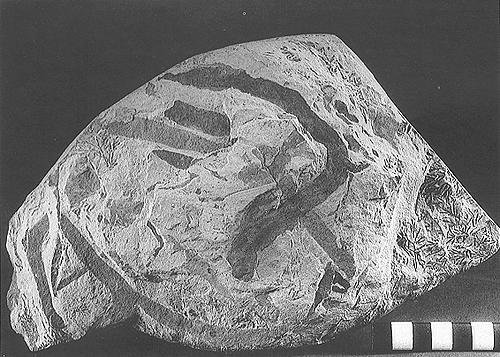
Problematic traces: Chondrites
Plate 158

Problematic traces: Chondrites
Plate 158
Another case of "problematic" trace is illustrated here in a sample of thinly bedded marlstone. The size and the areal pattern are variable; the bladed shape, the local dendritic arrangement and the dark green color are reminiscent of vegetal remains. This explains why these pellicular traces were interpreted as fossil algae and given the name fucoids. They are now seen as horizontal burrows flattened by compaction. The color is related to a relatively high content of organic matter and silicates rich in Fe2+ (iron in reduced state), suggesting that the burrowing animals lived in a poorly oxygenated (disaerobic) environment. The burrows were probably excavated a few millimeters below the sedimentary interface.
The structure can be regarded as a paleoceanographic indicator, if it is assumed that the amount of oxygen dissolved in deep-seawater depends essentially on density-controlled oceanic circulation. Water density is regulated, in its turn, by temperature and salt content (salinity), whereby the movements of water masses in a vertical plane are qualified as thermohaline. Chondrites should reflect conditions intermediate between aerobic and anaerobic near, and immediately underneath, the bottom.
Fucoid Marls (Lower Cretaceous) of Umbria-Marche Apennines, Italy.
| Photo: P. Ferrieri 1992. Scale is in centimeters. This and plates 159-162 are part of the collection of the Geology Department, University of Bologna. |